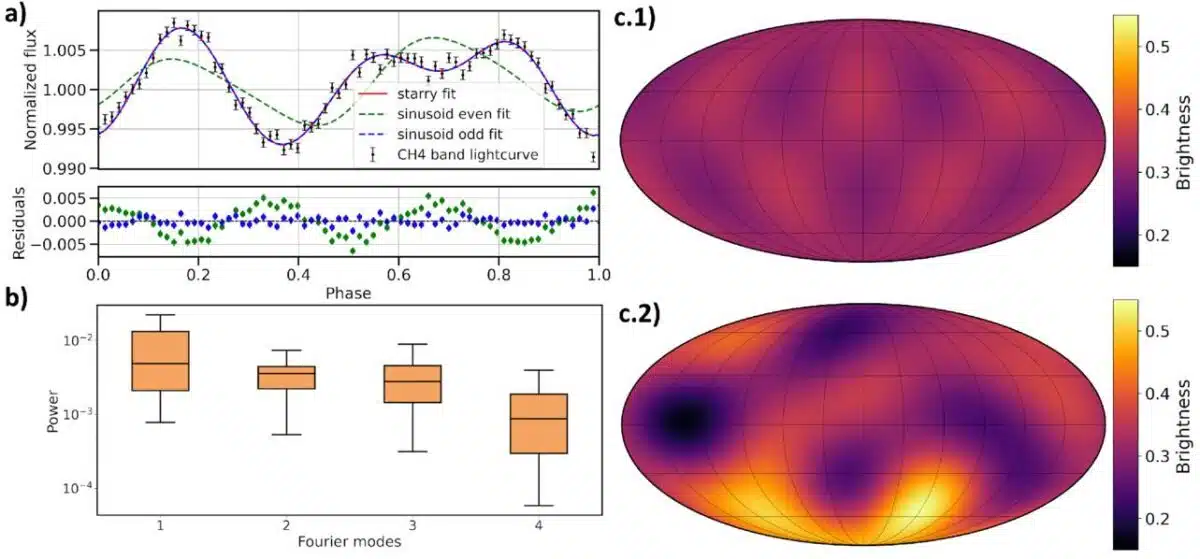The James Webb Space Telescope has captured an extraordinary glimpse of weather on a rogue planet 20 light-years from Earth. SIMP 0136, a mysterious brown dwarf, boasts an atmosphere of molten iron clouds and swirling storms more chaotic than anything observed on Jupiter.
Scientists now have an unprecedented look at the weather patterns of SIMP 0136, a planet that challenges traditional classifications. With a mass 13 times that of Jupiter, it sits at the boundary between a planet and a star, offering valuable insights into atmospheric behavior on similar objects. The research, published in The Astrophysical Journal, marks a breakthrough in using JWST to study the meteorology of exoplanet-like bodies that have no parent star.
SIMP 0136: A Planet Between Stars and Planets
SIMP 0136 isn’t just any planet. According to Roman Akhmetshyn, an astronomer from McGill University, it is a brown dwarf—too small to be a star, yet far too massive to be a typical planet. This object, with a mass 13 times that of Jupiter, floats freely through space, far from any star. As a brown dwarf, it shines faintly with its own light, allowing astronomers to study its atmosphere without the interference of a nearby sun.
Because brown dwarfs like SIMP 0136 do not orbit a star, they present a unique opportunity to study planetary atmospheres in isolation. The James Webb Space Telescope has provided an ideal tool to examine these objects, offering a direct view of their weather without the glare of a nearby star.
A Starless Super Jupiter.
SIMP 0136 is a free floating planet 13 times the size of Jupiter with a bright glow and a fast rotational rate of just 2.4 h per revolution. Located in our own Galaxy only 20 light years away (visible in the Northern sky), SIMP 0136 cannot be considered… pic.twitter.com/9Yw7yfNxNl— Maurizio Iβλἄ (@Dragonmaurizio) March 3, 2025
Mapping SIMP 0136’s Chaotic Atmosphere
Using the Near-Infrared Imager and Slitless Spectrograph (NIRISS), the study observed SIMP 0136 during its rapid rotation, which lasts just 2.4 hours. The findings revealed a highly dynamic and layered atmosphere, with at least three distinct layers of clouds and gases. The atmosphere is far from uniform; deeper layers contain molten iron clouds, while the upper layers are made up of grains of forsterite, a mineral also found in Earth’s mantle.
The study, according to Akhmetshyn, shows that the atmosphere of SIMP 0136 is not static. Cloud formations are constantly shifting, with intense variations in temperature and chemical composition.
“We suspect numerous small-scale patchy clouds of different temperatures and chemistry, scattered across the globe.”
The upper atmosphere contains carbon monoxide and water vapor, while lower layers reach temperatures ranging from 1,000 to 1,300 Kelvin, suggesting that the planet’s weather is in a constant state of flux.
 Analysis of the CH4 band lightcurve, Fourier modes, and corresponding brightness maps showing atmospheric variations. Credit: The Astrophysical Journal
Analysis of the CH4 band lightcurve, Fourier modes, and corresponding brightness maps showing atmospheric variations. Credit: The Astrophysical Journal
Asymmetry and Unpredictable Weather Patterns
Unlike the symmetrical weather patterns found on Earth or Jupiter, SIMP 0136’s hemispheres show significant differences in cloud distribution and chemical composition. This imbalance suggests the presence of jet streams, vortices, or possibly even banded atmospheric circulation patterns, much like those seen on Jupiter, but on a much more turbulent scale.
The researchers employed advanced data analysis techniques, such as principal component analysis, to interpret the results. Their conclusion: no single atmospheric model could fully explain the complexity of SIMP 0136’s weather. Instead, multiple models were needed to capture the planet’s dynamic atmosphere, suggesting a level of complexity and turbulence in its weather systems.
